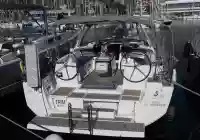Anyone who has ever chartered a boat knows that once you move away from the marina to find those secluded spots, it’s the anchor that weighs on your mind. Dragging anchors and anchoring mishaps are not for the faint-hearted, but one of the best parts of boating is being away from the noise and movement of a busy harbour.
With these tips you can build confidence and be anchoring like an old sea dog by the end of the charter week.
Anchoring
A range of factors play a part in securing your boat to the bottom of a harbour; the size of the anchorage, wind, current, bottom topography and depth, and the equipment provided. There is a great difference between anchoring in 5m of water on a visible sandy bottom and anchoring fore and aft in a deep anchorage with murky water. In most cases a pre-charter briefing will provide information on good anchorages, and warn you about any that should be avoided. Local knowledge and advice should always be heeded.
First things first, familiarize yourself with the type of anchor and rode on your charter. Always test the winch, making sure it is in good working order and that you know how to operate it well. There should be depth markers on the chain which will help you keep track of how much chain to let out. Most charter boats have all-chain rodes, typically about 50m. For your first attempt at anchoring and getting skilled at boat maneuvering, it’s good to be out somewhere open where you can play around. Do some drills with your crew and get back into being onboard.
Basic Rules
The Basic rule is minimum rode/depth ratio to should be 4:1 (with rode being the chain that is attached to the anchor) Although this is the generic rule, the amount of chain on the bottom is always a consideration and depends on the environment you have anchored in. Each time you anchor, as soon as the engines are off, someone should dive in with a mask to check that the anchor is secure.
If there is plenty of swinging room, you could let out a lot of chain whereas if it’s a tight anchorage with a danger of swinging into other boats, you can't let as much out. Mind always on the wind, keep an eye on the amount of chain on the bottom by letting some out or in. If the wind really picks up and the anchor is not holding it may be wise to move on.
Step by step guide
Once you have found the ideal spot these are the steps to be followed:
1. Come to a halt over the place and drop the anchor. Be careful not to drop a lot of chain right on top of the anchor;
2. Let the boat move back, gradually, on its own paying out the chain without moving the anchor;
3. Secure the anchor chain on deck;
4. Wait for a few minutes while the anchor digs in;
5. Motor slowly astern (backwards) until the chain straightens out;
6. Watch the chain carefully to notice any jumps in the chain which is an indication of a dragging anchor;
7. If all seems well increase engine revs and check again for dragging;
8. If the anchor is dragging, pull it up and start again; If not, then secure the chain and relax!
Anchoring etiquette
Boats already anchored have claim to their space, including their anticipated swinging room and are not expected to move if you are too close later on. Some boats are equipped with an anchor alarm on the GPS which can be set for peace of mind. In addition, don’t forget the anchor light if you're not in a specially designated anchorage area.
Weighing Anchor
When it is time to leave, it should be an easy procedure. While you're warming up your engine, make sure the chain and winch are ready. You may reduce the strain on by slowly motoring forward as you raise your anchor. Use hand signals to communicate with the person at the helm. Be sure to secure your anchor properly before increasing speed.
If your anchor becomes stuck on the bottom, shorten the length of the chain a bit and position your bow directly above the anchor. Slowly move forward and try to raise it. If it doesn't break loose, let out a little chain and circle the anchor keeping the chain tight. Often a slightly different angle will dislodge a stuck anchor. If it's still stuck, try positioning the boat in the opposite direction to which you were anchored. The force of pulling in the opposite direction should be enough to dislodge it.
Mooring
Moorings are often placed in harbours where it is either difficult to anchor (and usually provide a worry-free night’s sleep) but they do come in many varieties and are rigged accordingly. You may need to pick up the float with a boat hook. Three good tips for mooring are to make sure you it’s a public mooring, pay any mooring fees and in bad weather, weigh the benefits.
As with all things, practice makes perfect, so take any opportunity to charter a boat and master your anchoring skills.
By Merryn Wainwright




